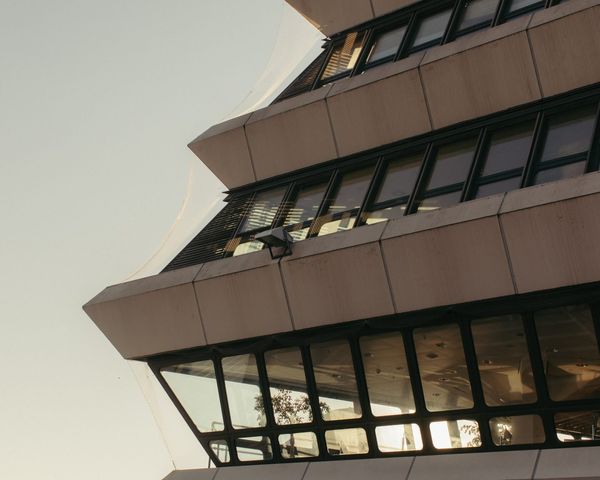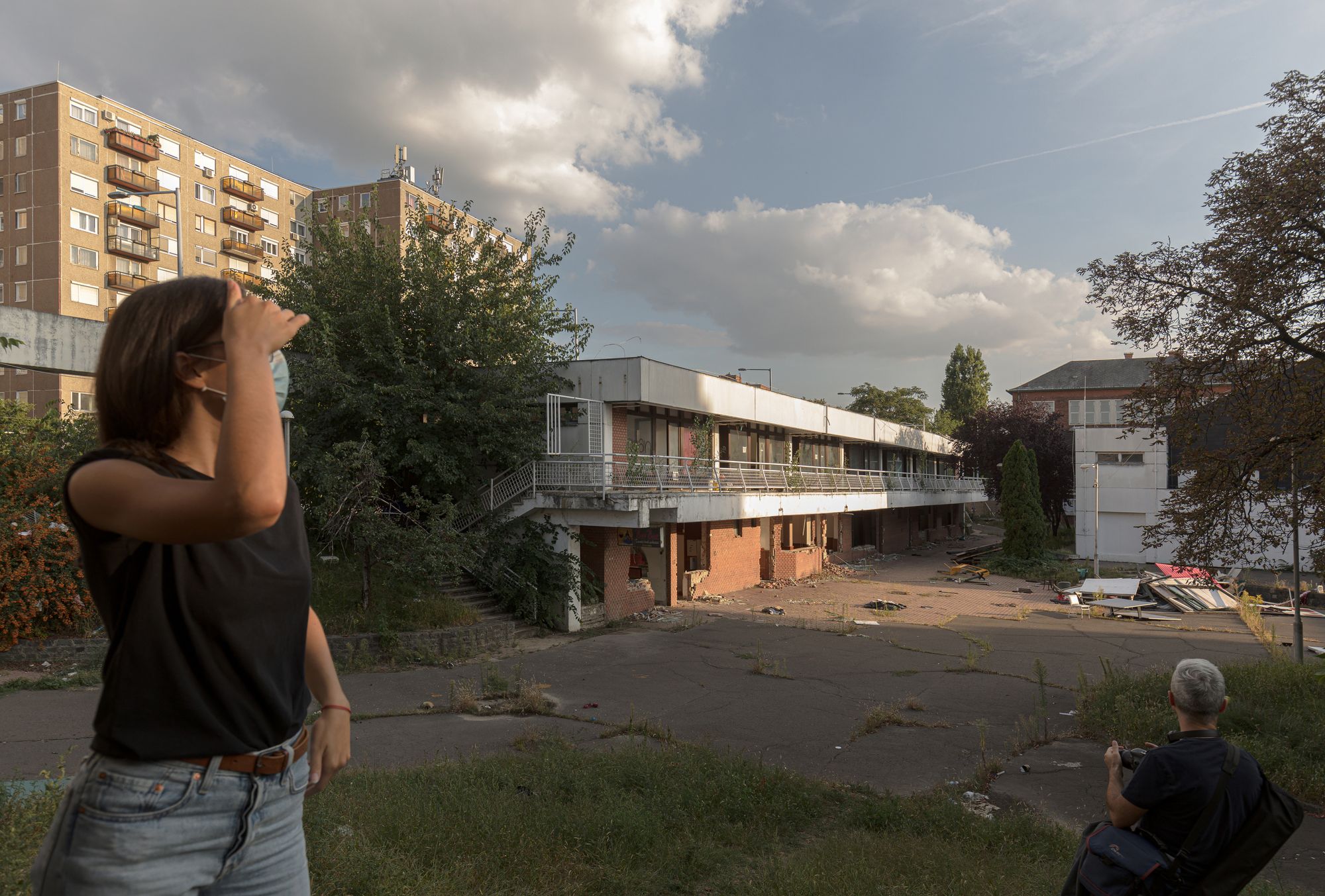The latest urban walk related to the Othernity project focused on Újpest. In addition to the boarded-up building of the Endre Ady Cultural Center, we also examined the first cultural facility of the district, Polgár Centrum (Citizen Center) as well as the building of the New Market Hall and Cultural Event Center of Újpest handed over in 2018, too. Cultural institutions in space and time, in District VI of Budapest. Let’s see!
The latest urban walk organized by Contemporary Architecture Center (KÉK) invited those interested in what happened over the past decades in District IV of Budapest – at least in terms of architectural projects – for a true travel in time. KÉK has already announced the first version of this tour earlier, when they planned to walk through the Endre Ady Cultural Center closed in 2018, but the demolition of the cultural center was decided in the days leading up to the walk, and so they had to cancel the tour. The cultural center designed based on the drawings of Ybl and Kossuth award-winning architect István Ferencz is now waiting for its doomsday all boarded up after 32 years of operation.
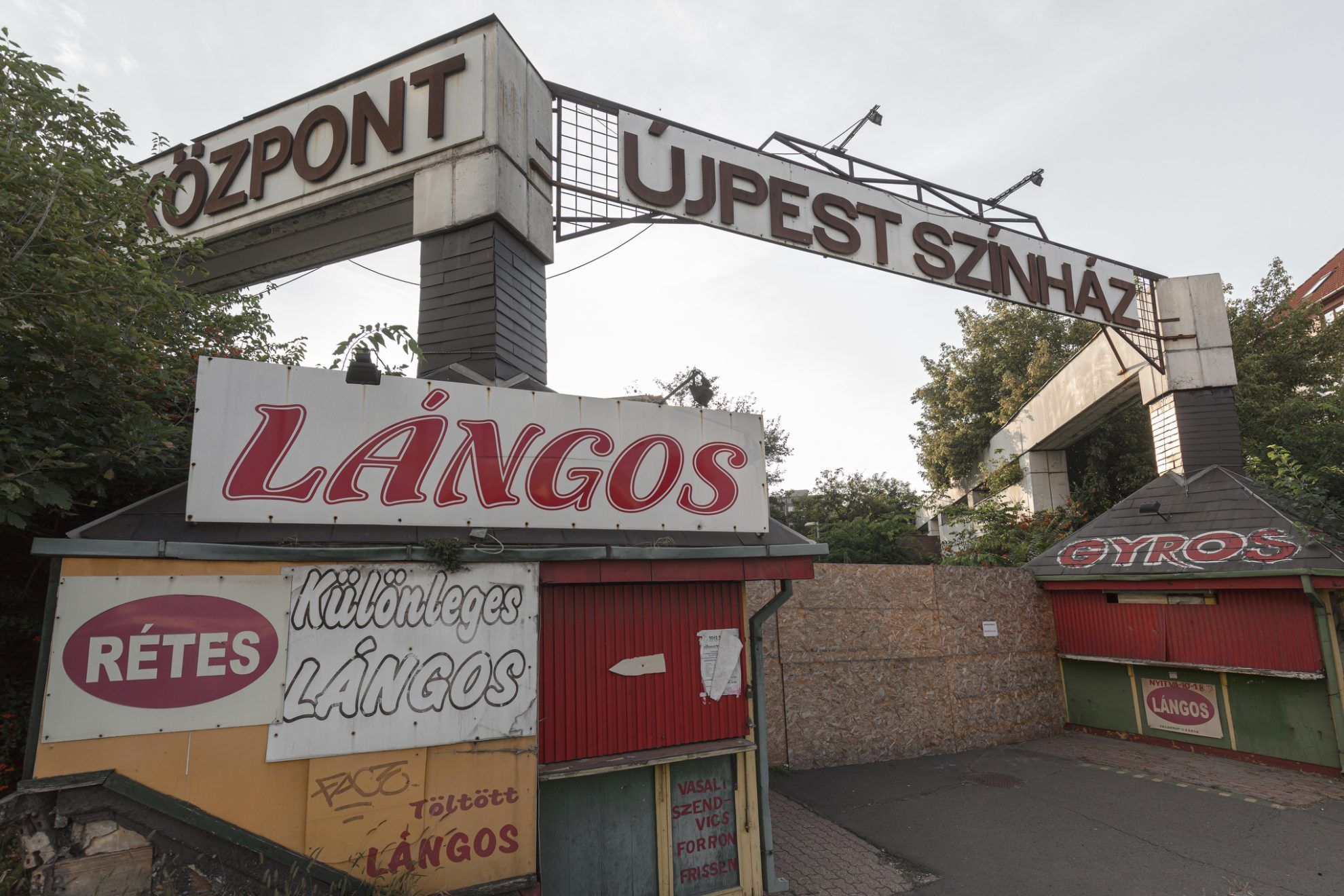
The good in the bad is that even though we could only approach the cultural center fallen into disrepair with a guerilla method, the organizers also added the Polgár Centrum located on Árpád út and the building of the new market hall standing at Szent István tér into the itinerary. János Iványi, the president of the Foundation of Local History presented the former building as well as the roots of cultural management in Újpest. The building giving home to Polgár Centrum blends in with the shops on Árpád út, and the giant block of Újpesti Áruház department store does not help the unsuspecting visitor either to notice that there is cultural life behind the door under the awning. Perhaps only the plaque hidden well on the façade, honoring Genoa-born Hungarian painter Celesztin Pállya could give rise to some suspicion. The situation is further aggravated by the fact that another entrance of this very same building leads to a whole other place, to a Chinese restaurant titled “Panda”, which is hardly compatible with the character of Polgár Centrum in terms of aesthetics, either.

And what called to life Újpest’s first complex community cultural facility? The Újpesti Közművelődési Kör (Újpest Cultural Group) established by Dr. Gyula Ugró in 1877 needed a permanent place to meet, which would also give space for implementing various cultural events. “The fondest wish of Ujpesti Közművelődési Kör will soon be realized, as they are building a new home for themselves right in the center of Ujpest, on Árpád út. To this end, the group bought Neumann Sámuel’s real property and will build their ornate palace there during the year” – says a newspaper of the time.[1]
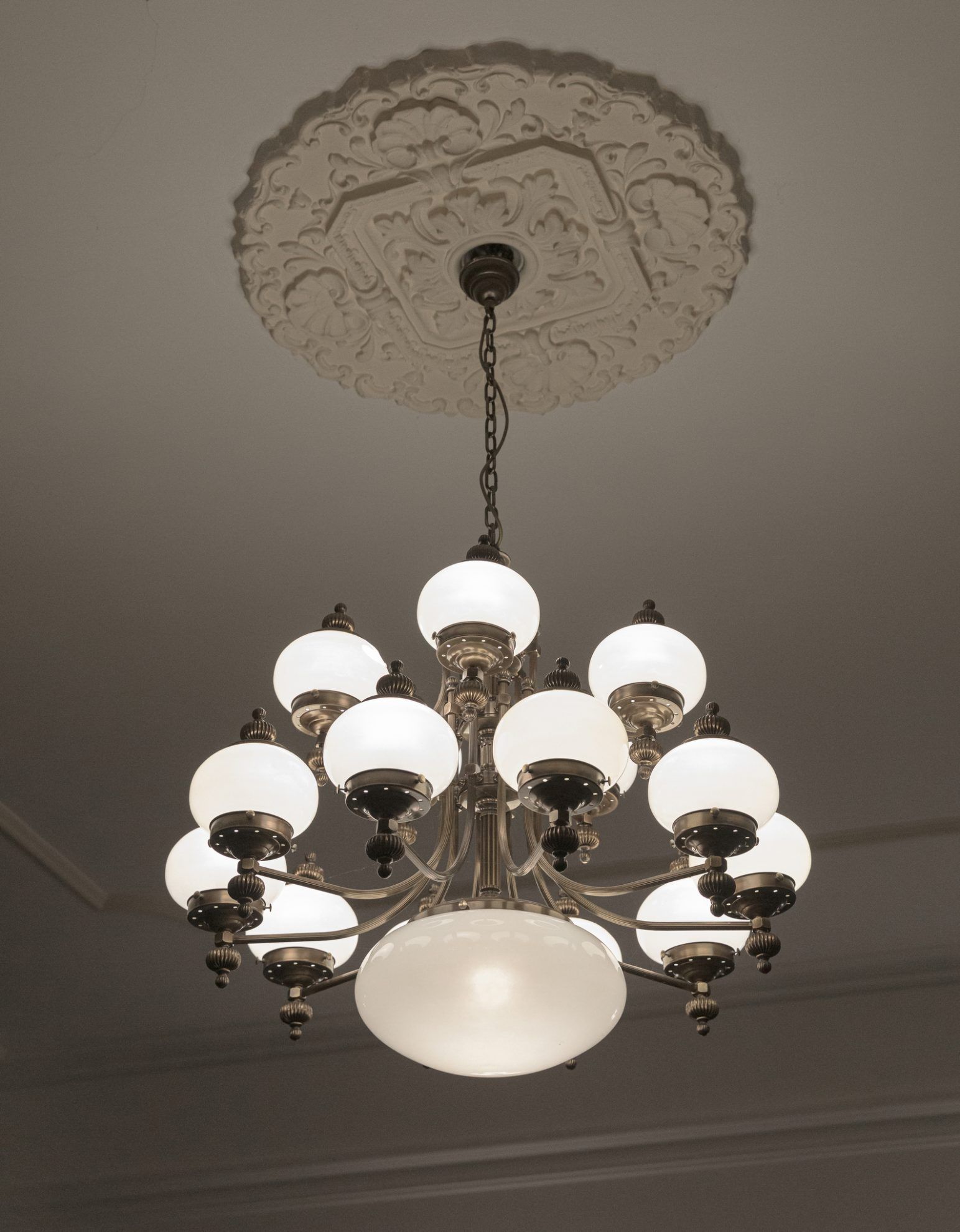
According to sources, the building was built based on the drawings of architect Frigyes Kovács also designing Zichy Palace, however, according to newspaper Társadalmi Lapok, the designs of József Gábory standing behind the motto “Közművelődés” won the announced call, while Lajos Kőrösi was in charge of construction. Finally the building was handed over on December 17, 1898. “A very well-lit auditorium and dance hall decorated with elegant mirrors and a giant chandelier, with a very comfortable billiards room boasting a fine table welcome visitors, the dining room is sufficiently spacious, the reading room, the card room as well as the official rooms are very practical, and the furniture show fine taste, all in all the exteriors of the palace are quite outperformed by its interior.” [2]

The former grandeur of the center was somewhat conserved for posterity in the course of the reconstruction carried out between 1988 and 1994: snow white walls, gilded chandeliers and dark red drapes take us back in time in the rooms still used to this day. What made our heart really skip a beat was the theater hall capable of seating 135 people.
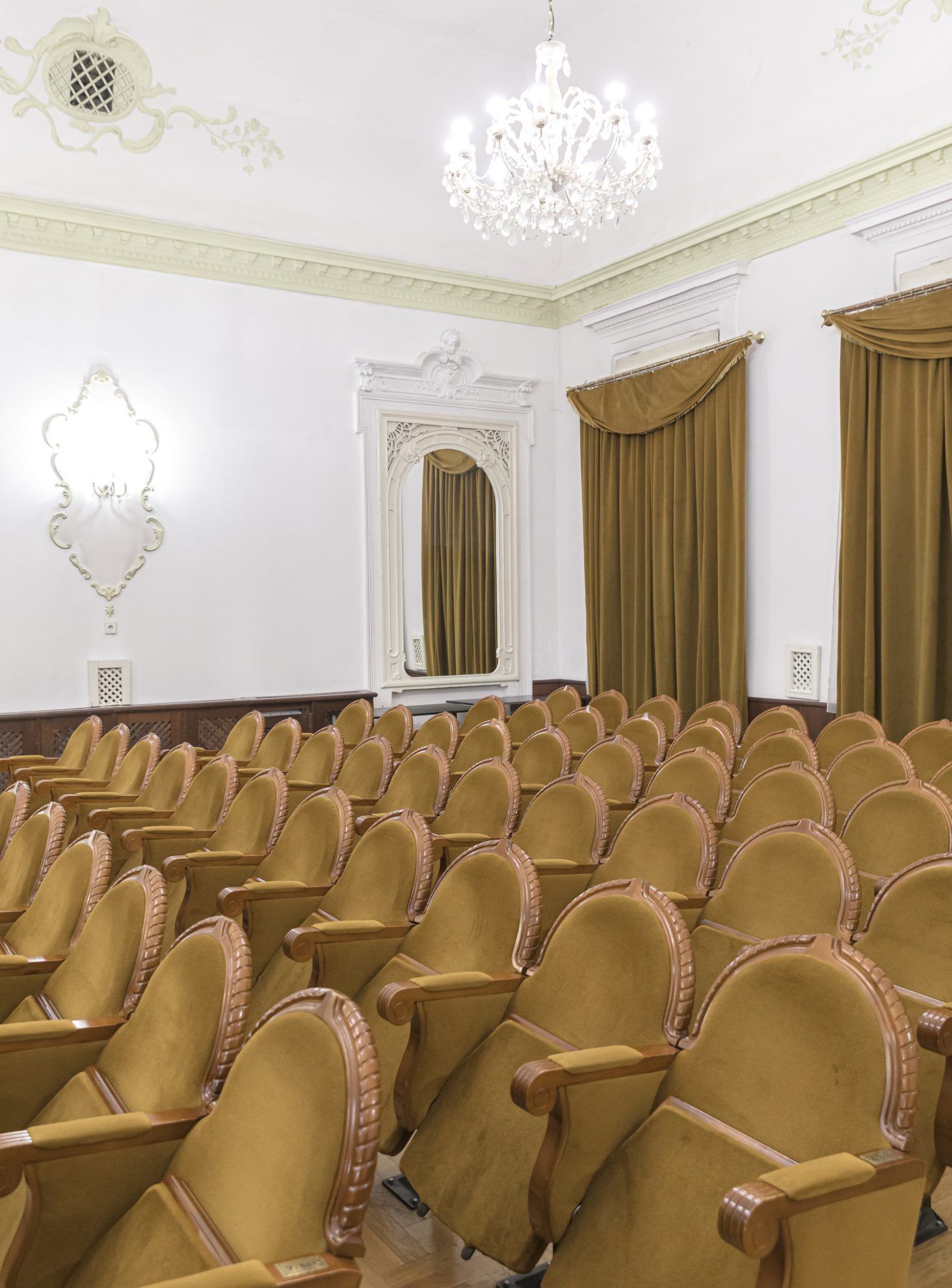
The next stop of our tour was the Endre Ady Cultural Center on István út – an iconic building that has seen better days, also the youngest one in the Othernity project. Unfortunately we couldn’t enter the building, but we still got to learn a lot about the cultural center designed by István Ferenc (interior designer: Margit Köhler), which, as a matter of fact, goes way beyond the concept of a simple house: the architect did not imagine the cultural events of the late eighties as something closed into a single block, he wanted to use the entire lot available for the project, and he wanted to do all this by keeping the building complex in harmony with the unique urban fabric of Újpest. This area was incorporated into Budapest officially in 1950, and the district managed to preserve its town character unto this day with its row houses and cobblestone streets.
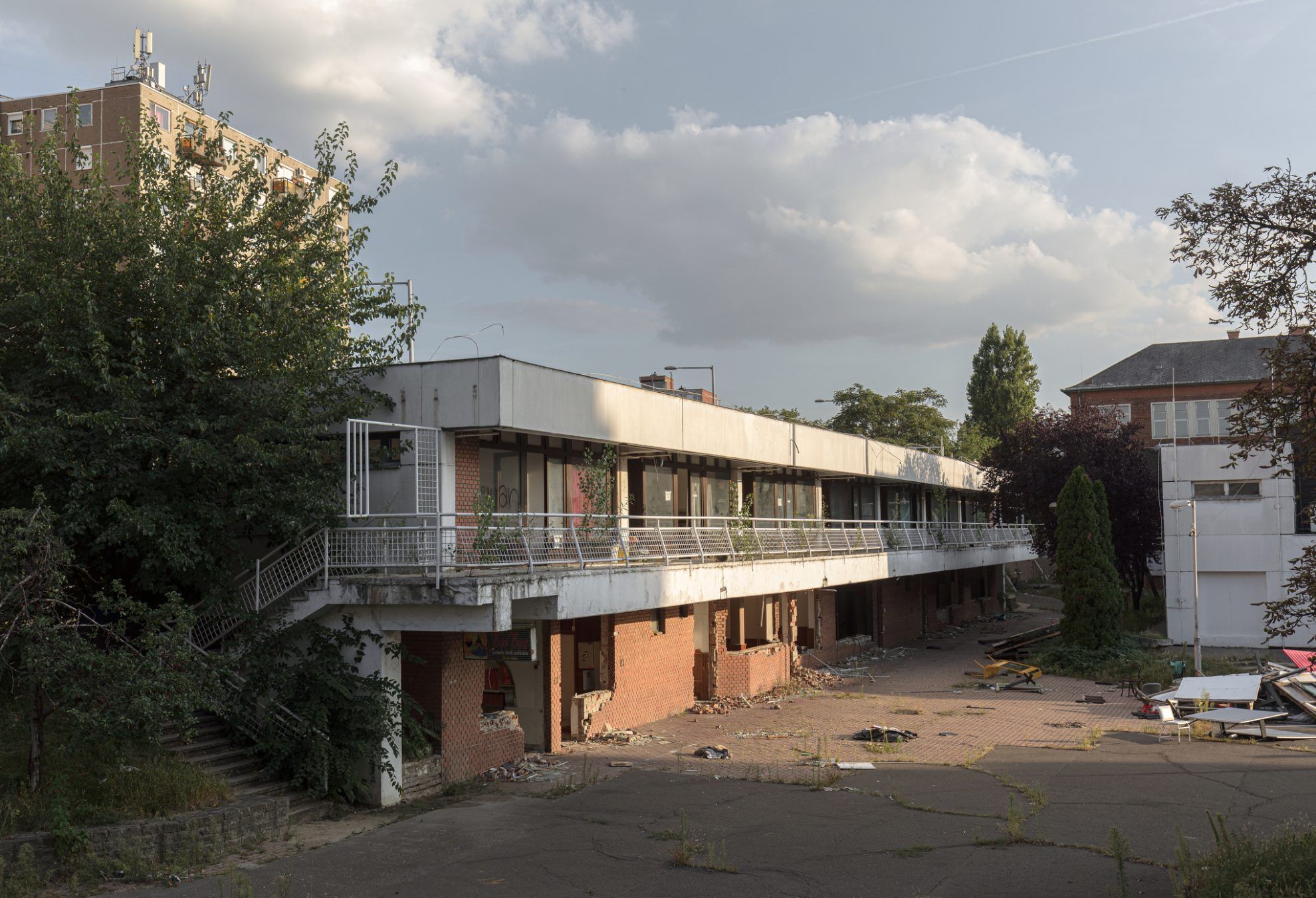
Along the “town in a town” concept, Ferenc designed an open, freely useable space structure, and enclosed it with a UNIVÁZ framework – as if he actually surrounded the cultural center without keeping anyone away from the building.


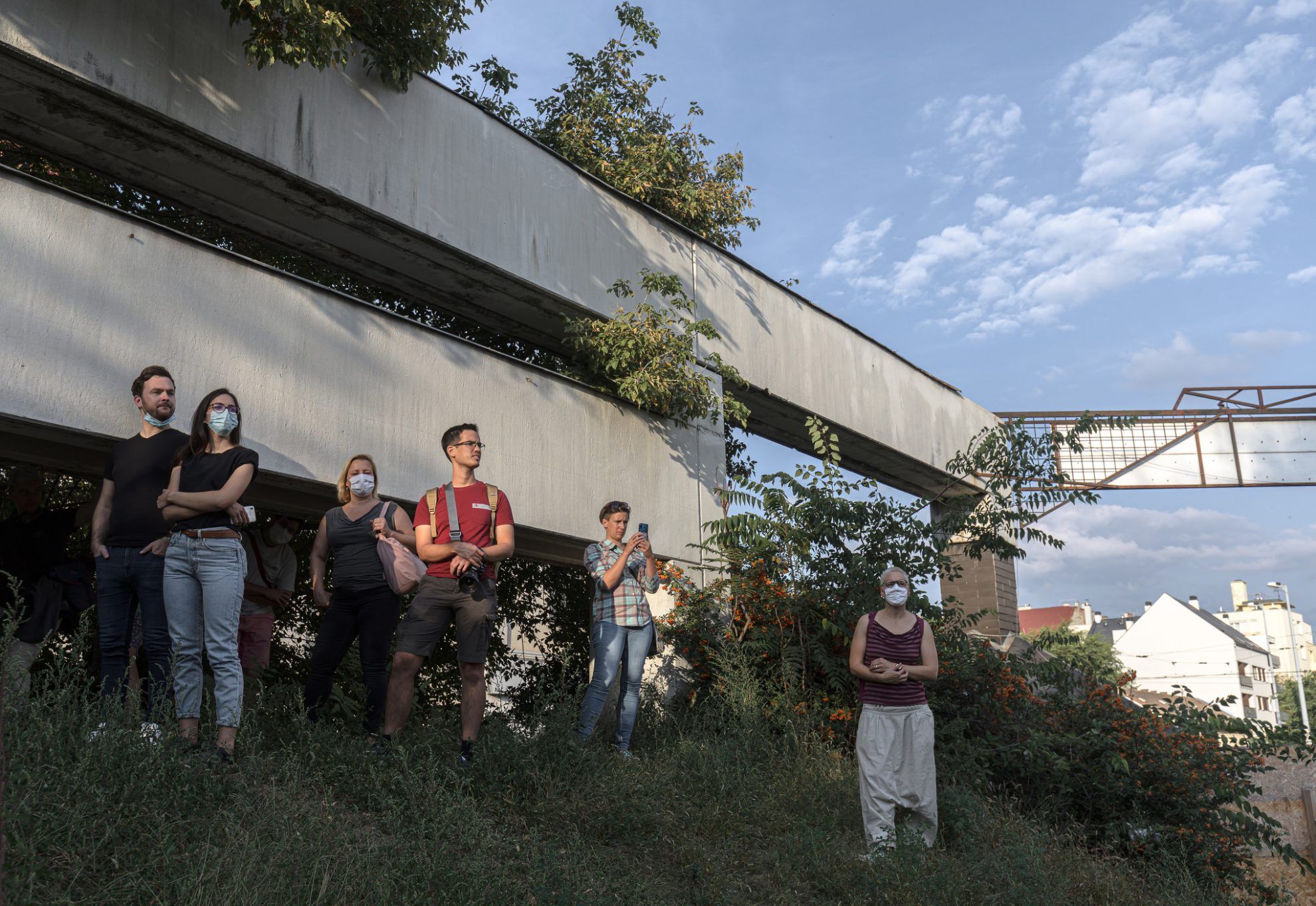
The Endre Ady Cultural and Training House was handed over to the public on May 1, 1986. And what did the people of Újpest think about the new complex?
“The single-story, two-winged, black and white building complex of the new cultural center arouses curiosity in this environment – it stands like a… like what? A manor with a rampart? An open fortress? Or a play castle? In any case, it’s odd, interesting, a bit strange still. And by the time I walk through its spacious yard and the interiors of its main building (which are not too excessive in terms of size, yet still feel quite spacious) I realize what it resembles: an ancient, small town agora, that is, a marketplace (…).”[3]
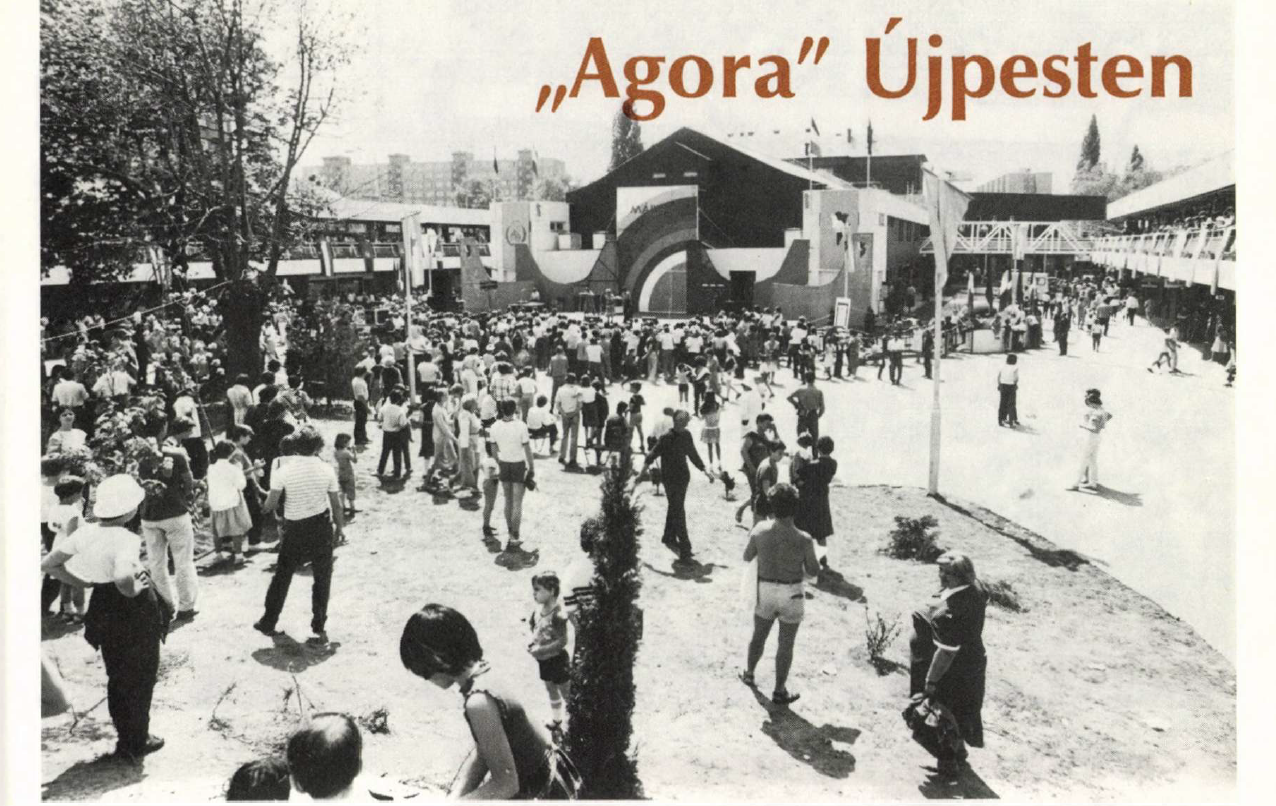
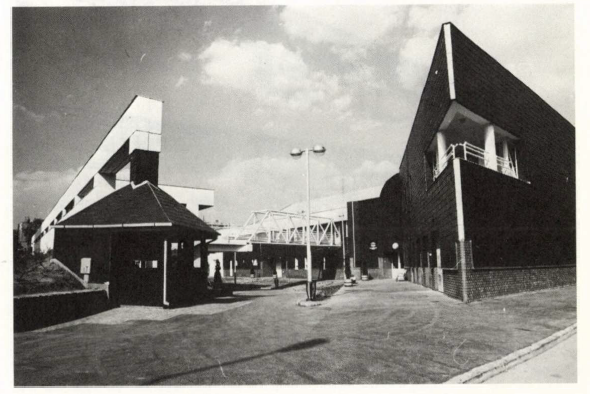
Stores opened on ground level of the building complex designed between 1983 and 1984, and built between 1985 and 1986, the first floor gave home to lecture halls and club rooms, while a multifunctional theater hall was established on the ground floor of the main building. The leader of our tour, KÉK volunteer Orsolya Dabóczy also shared some printed sketches with us, drawn by Ferencz himself when designing the building.
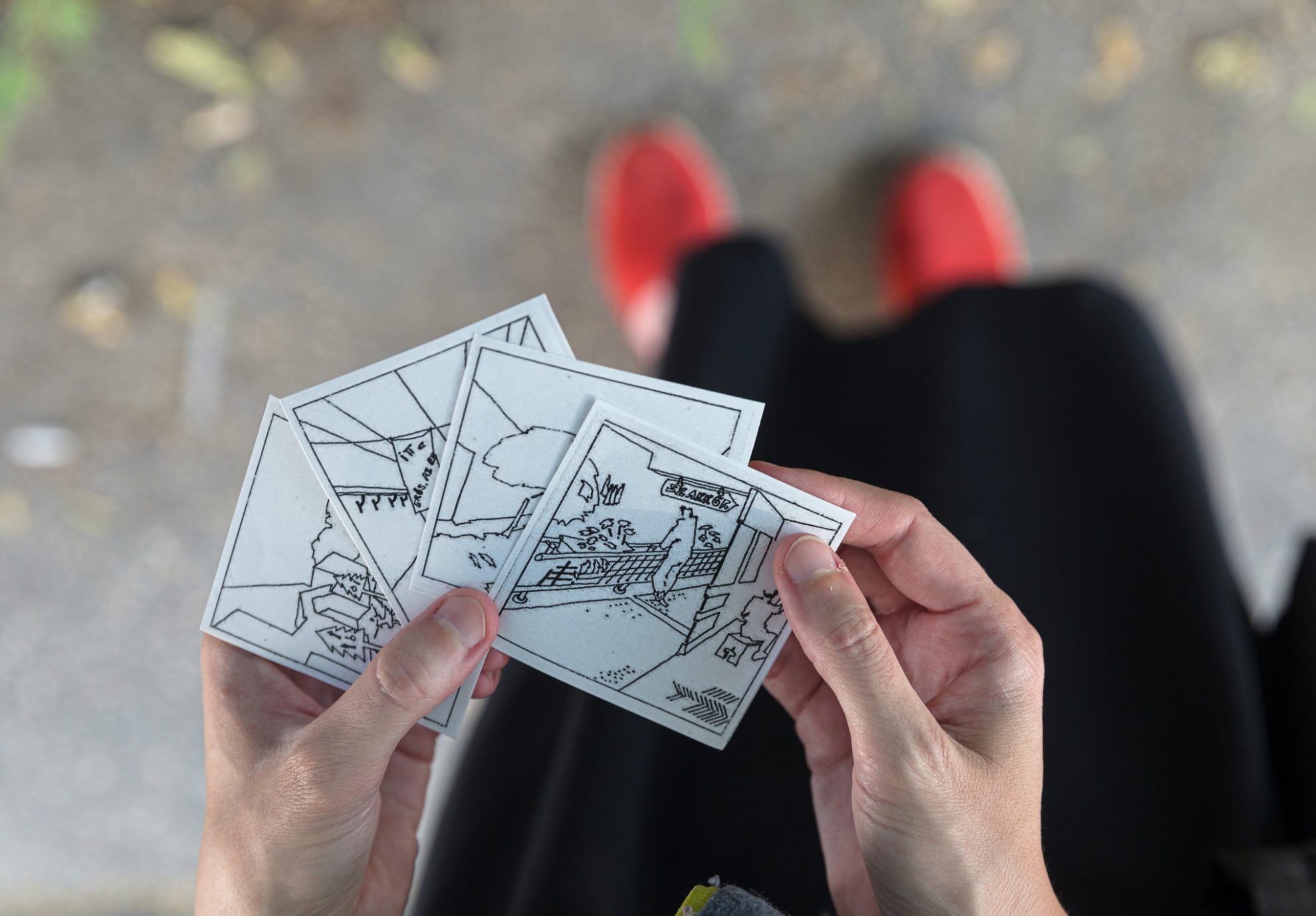
And how did the building look at the time of its handover?
“If we look at it from the streets: the grass-covered rampart rising to approx. three meters on the short ashlar base and the walls leaning on it promise protection, while the booths (sweets, tobacco, newspaper, ice cream) standing as guardhouses at the entrances on the four corners invite passersby inside. The shopping arcades (flower shop, bank, leather goods store, school and sports articles, bookstore and gift shop, clothing store, café) (…). There is two club rooms, a computer room with green cabinets and shelves, a study and playroom, a sewing workshop and an office on one side; if we go to the other side, we pass the large hall suitable to seat 350-450 people with chairs that can be moved freely and a demountable stage, the airy and cozy cinema with 150 seats and the ballet room with mirrors, and we arrive at the other wing; there is a lecture hall with yellow chairs and tables, a language lab with 18 headphones and a photography lab, and another study and club room, followed by the visual arts room and the ceramics workshop with an electronic oven. Somewhere in the middle there is the room of cultural organizers.”[4]

The press of the time compared Ferencz’s building to a ferry, and well, they were not far from the truth. The bridge with white railing connecting the first floor parts resembles that used on the deck of boats, and the round portholes, sharp corners and architectural details resembling bows echo through the building.
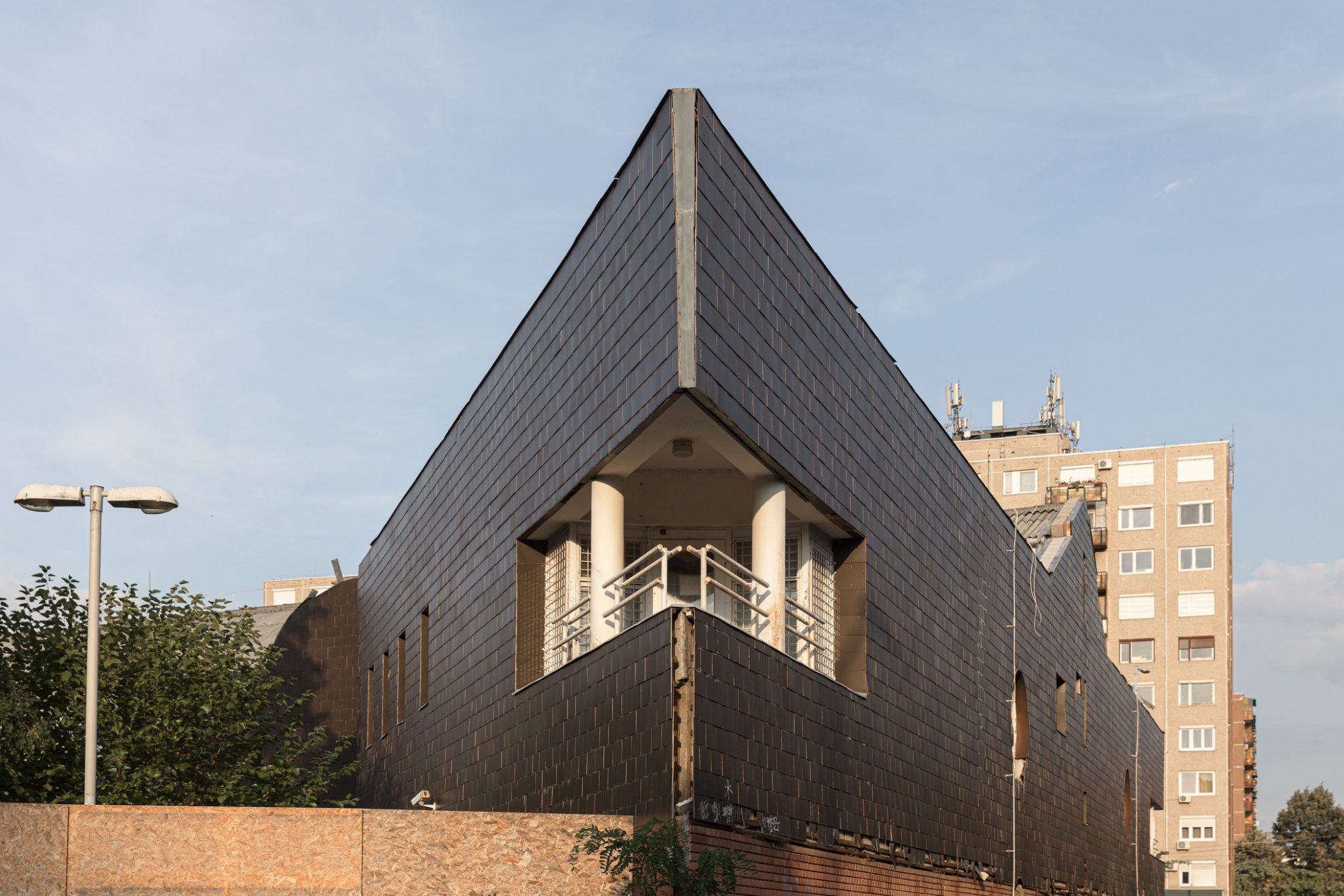
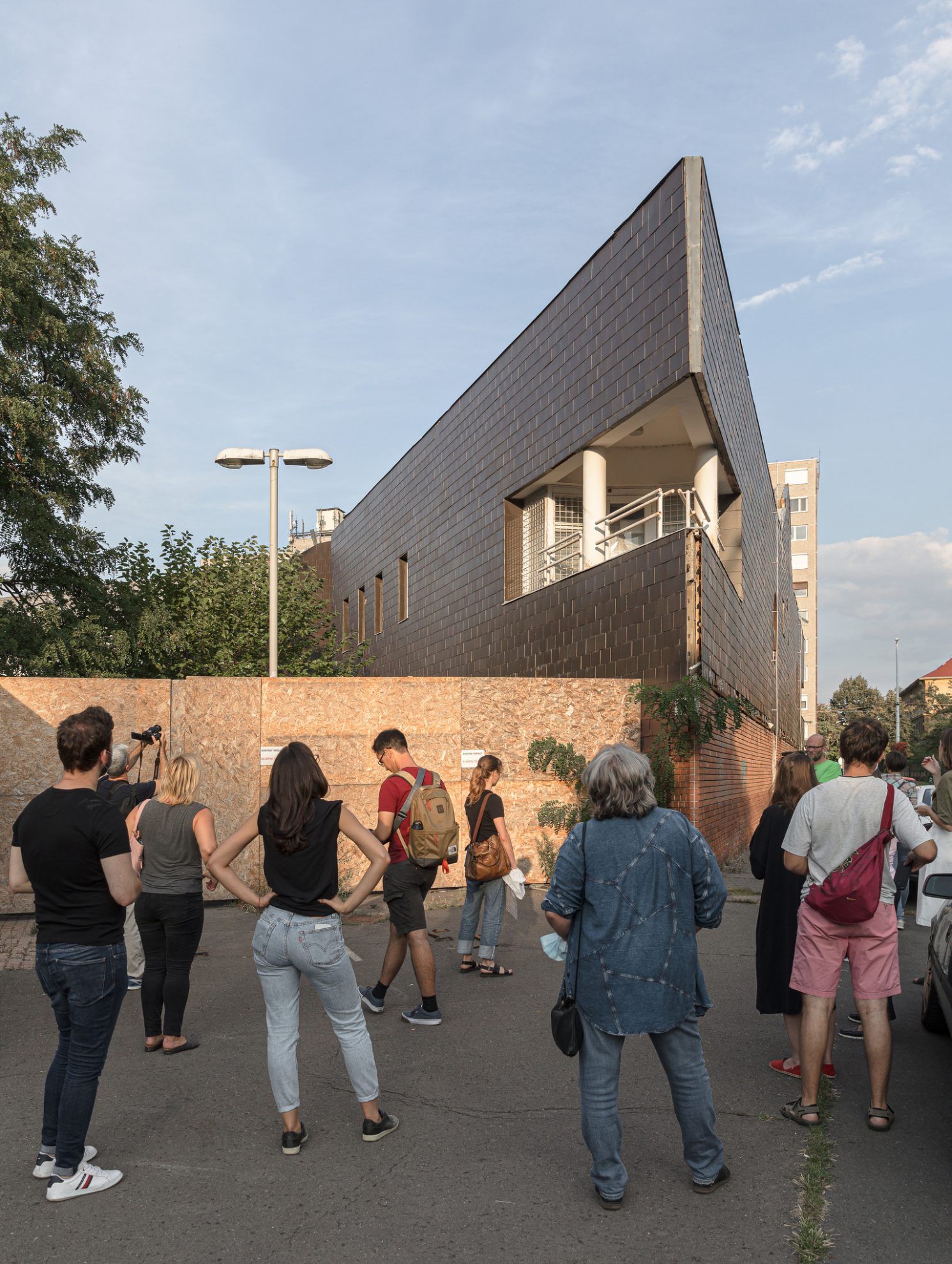
The last stop of our walk was the Újpest New Market Hall and Cultural Event Center, presented to the participants by Zoltán Bun the lead architect of Firka Stúdió Kft. The goal of designing the multifunctional building complex and the related square was to free the previously overcrowded and chaotic space through the construction of the new building – this is where the former market stood, with several quite different buildings and eateries also accessible from the street side. Only the round structure formerly functioning as a flower market remained from the old building complex, and an incomplete transformer box. This, and the so far unbuilt gravelly area surrounded with a fence considerably deteriorates the vista of the otherwise promising market building.

One thing that has no signs at the moment, and we have no idea when it will be completed is the multi-story promenade and the green walkway designed here, supposed to start at the side of Szent István tér facing the city hall, and would lead up to the first floor of the new hall. According to the plans, catering units would be placed under the promenade, and the flower market currently forced into the hall could also move under the arcades.
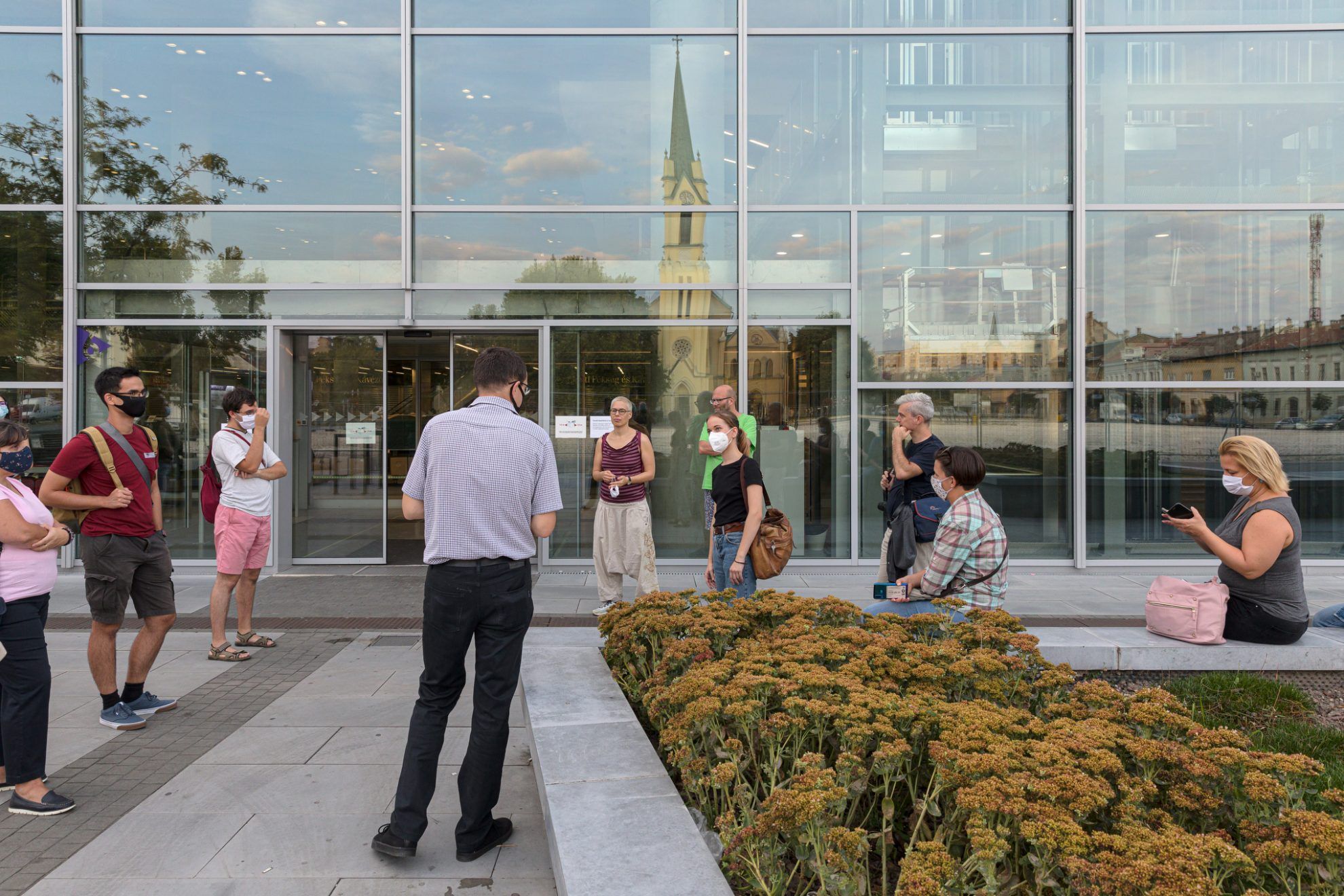
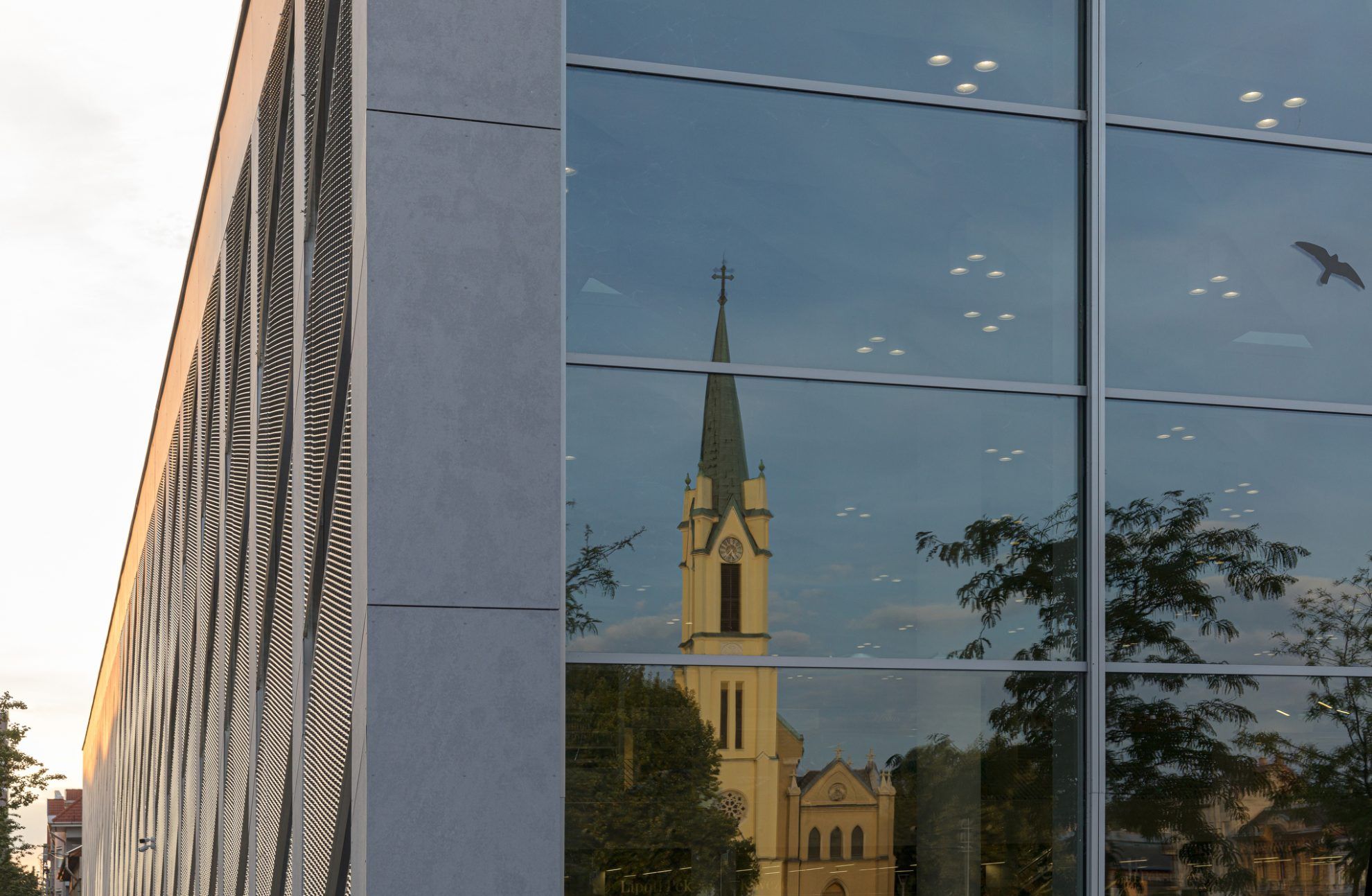
As the market itself is a very colorful and organically changing phenomenon, the designers dreamt up a neutral, subdued building: we see naked, raw concrete structures on the inside, they incorporated metal sheet shades on the front, and added artificial lighting to ensure the building is well-lit.

Designing a market is particularly challenging as many times the vendors themselves shape the space, and all the architect can do is to create a sort of system in the chaos full of life. Re-stocking and parking take place in the two-story underground parking garage, access is facilitated by service and passenger elevators: the three panorama lifts are especially spectacular, allowing visitors to admire the Catholic church of the square.
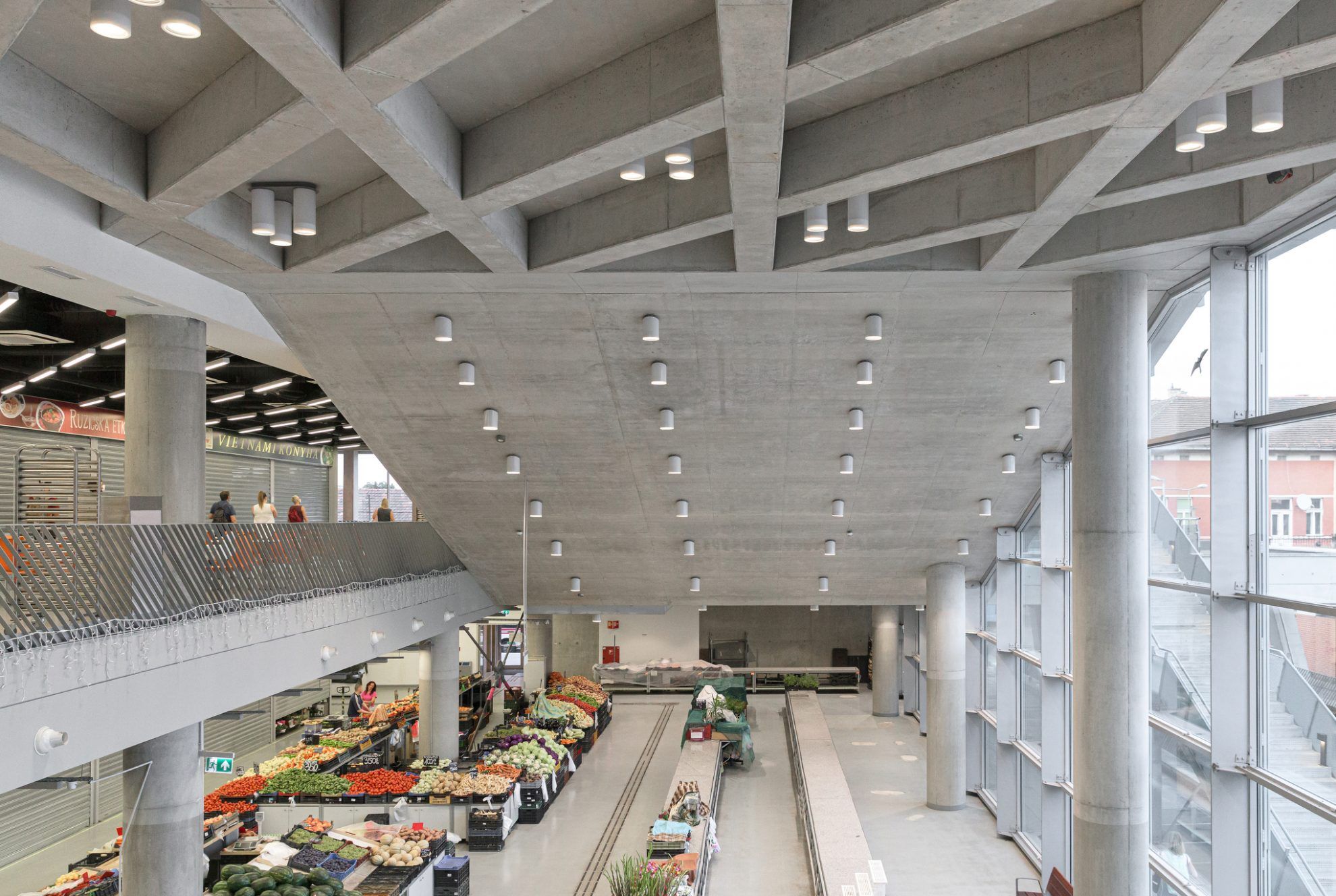
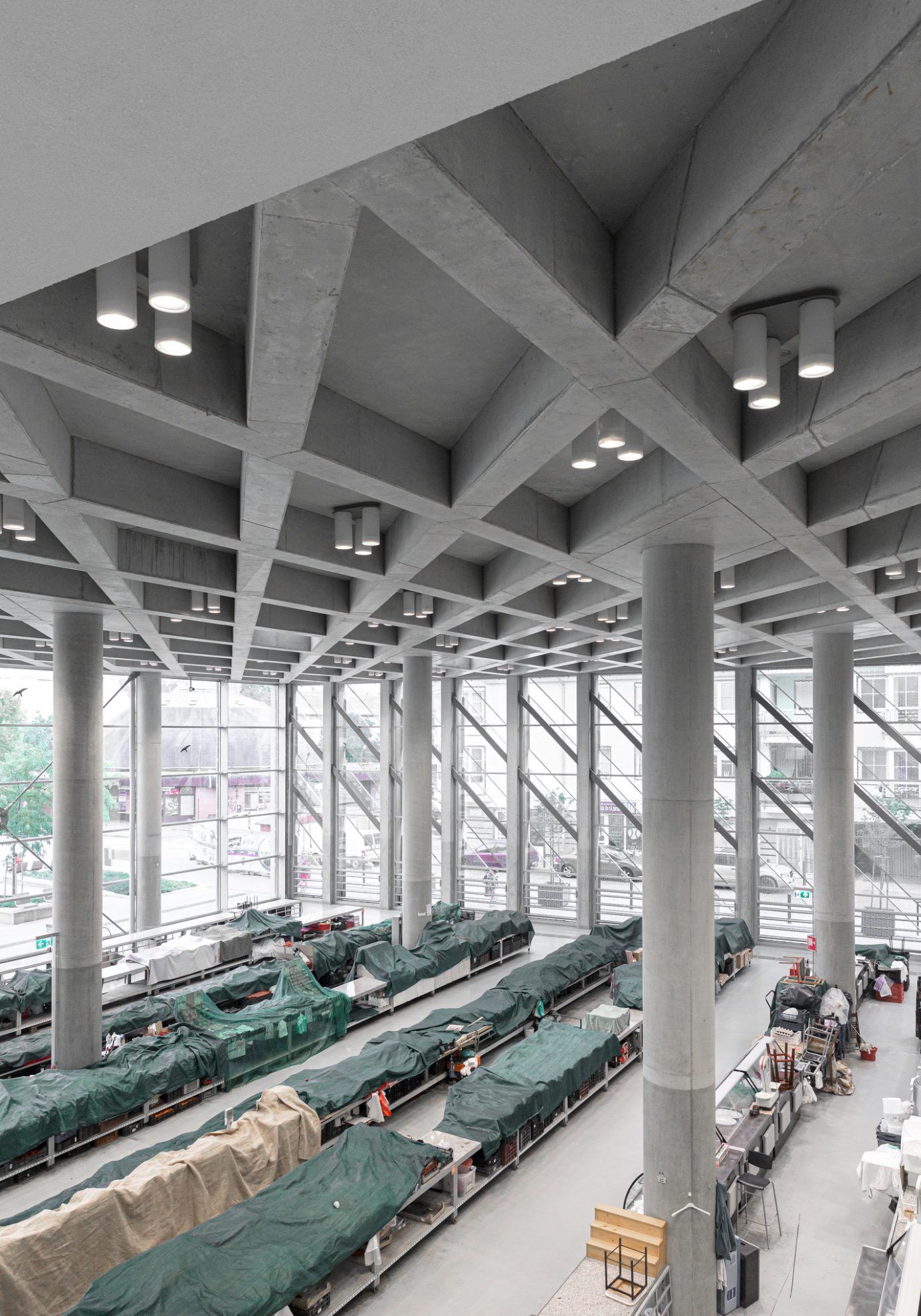
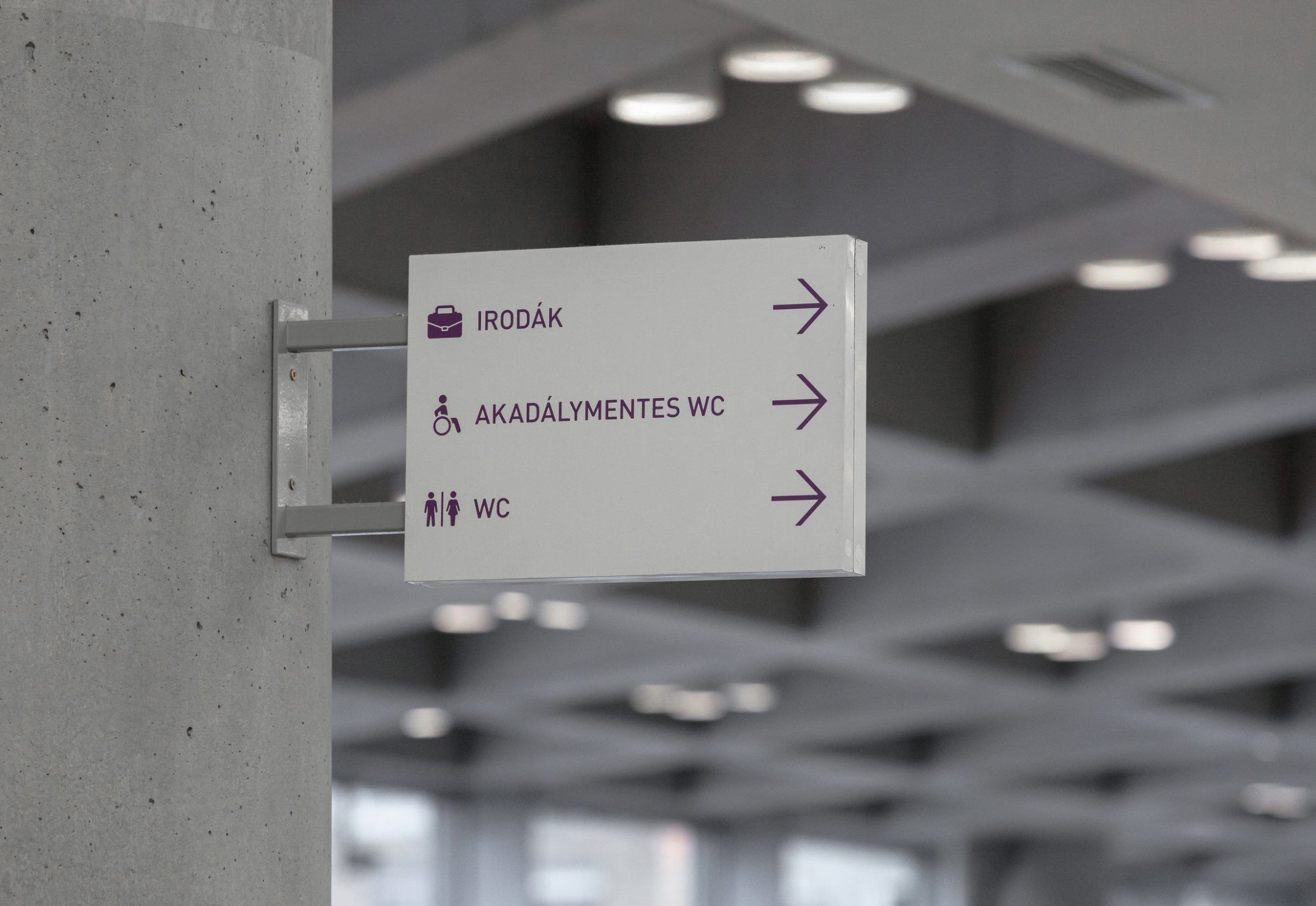
Various eateries are located on the first-floor gallery, from where one can access the event hall with an escalator, where a spacious roof terrace furnished with modern furniture welcomes visitors.
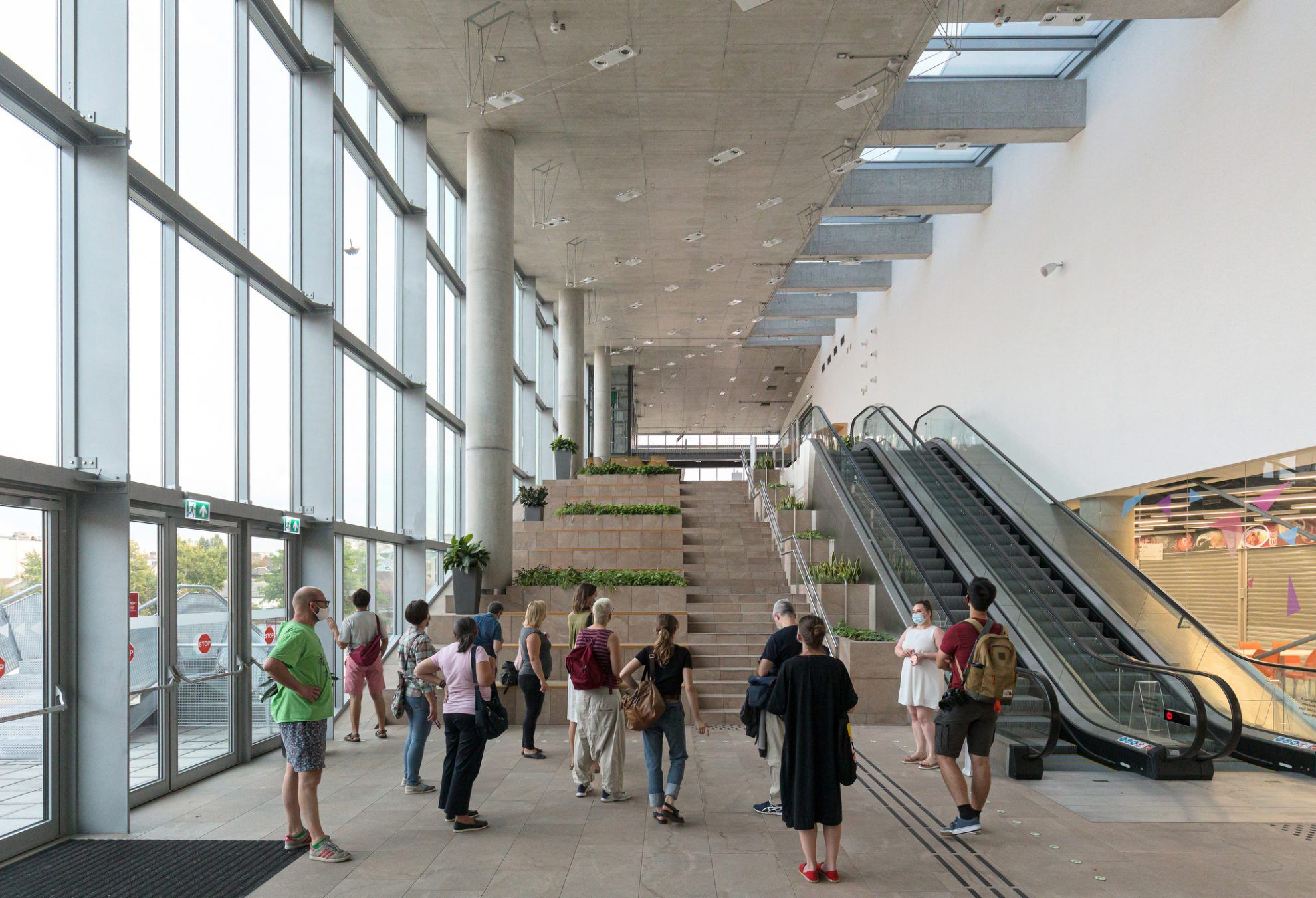
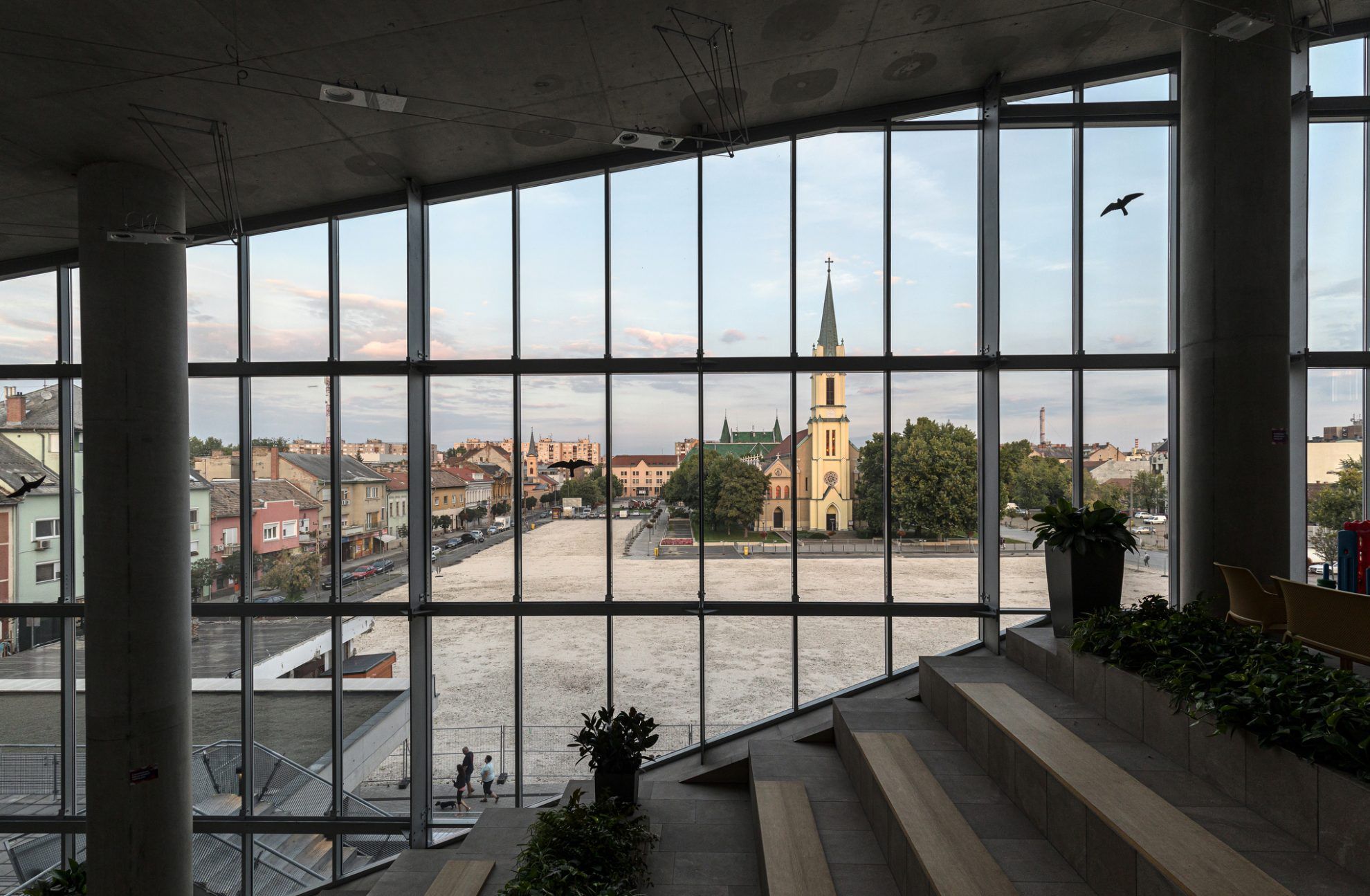
The theater hall equipped with state-of-the-art theater technology equipment and capable of seating 460 people can be used universally: the cascading auditorium full of chairs can be transformed into a flat space if need be, and thus the hall can give home to standing receptions and school celebrations in addition to theater performances and concerts.


Of course, whether the building of the new event center and the market will share the fate of Endre Ady Cultural Center in a few decades remains to be seen – only time will tell how the modern agora of Újpest will fulfil its function.
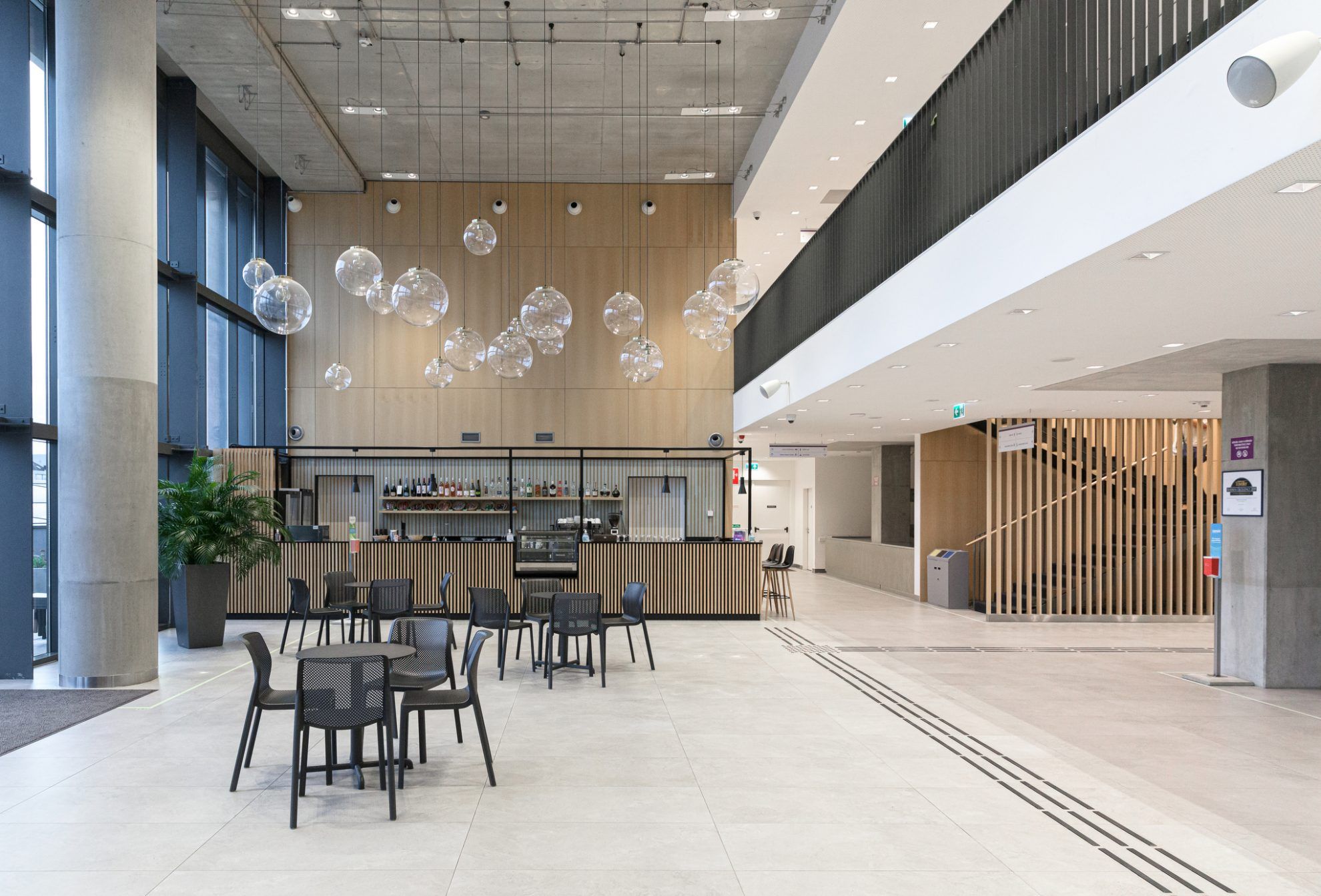
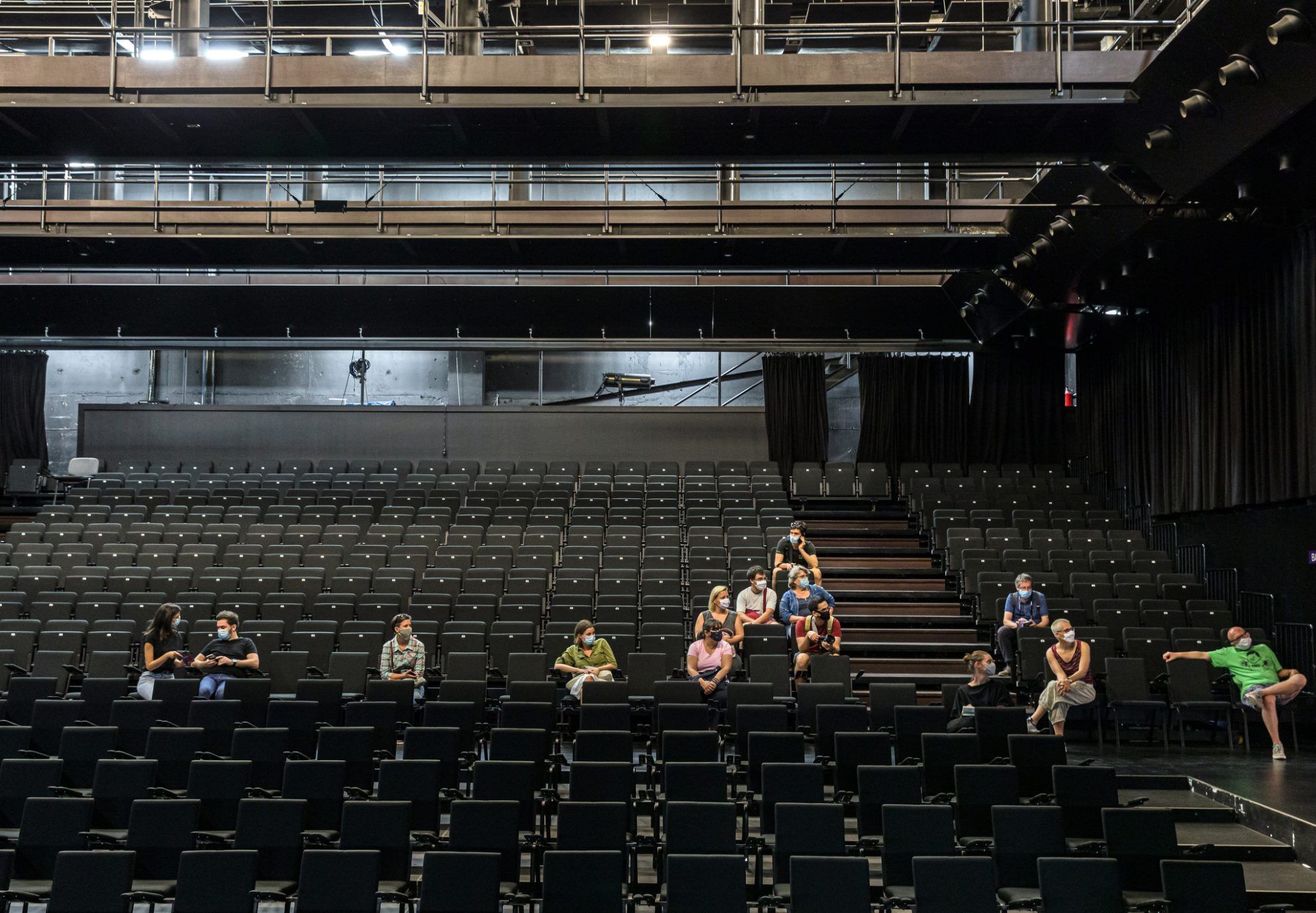
Photos: Balázs Mohai | Web | Instagram
In our series we tell our readers about the walking tours organized by the Hungarian Contemporary Architecture Center (KÉK), in relation to the “Othernity” project. The “Othernity” project presents 12 iconic buildings of the modern architectural heritage in Budapest through the lens of 12 contemporary Central-Eastern European architect studios. How and in what manners the contemporary groups reinterpreted the emblematic buildings of Budapest will be shared with those interested in the Hungarian Pavilion of the International Architecture Biennale in 2021.
[1] Társadalmi Lapok, January 10, 1897
[2] Társadalmi Lapok, December 18, 1898
[3] Béla Kajdi: „Agora Újpesten”, Népművelés, June 1, 1986, p 7
[4] Béla Kajdi: „Agora Újpesten”, Népművelés, June 1, 1986, p 7
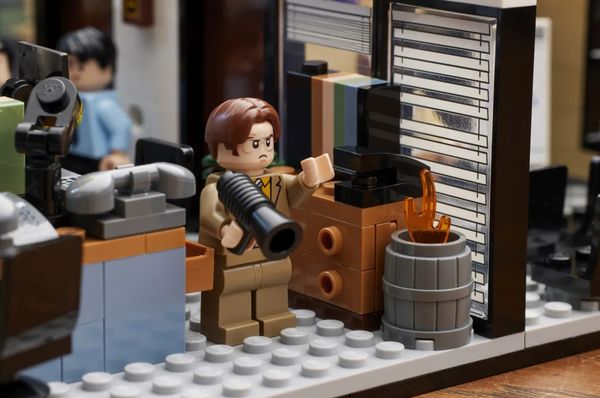
Fans’ dream comes true: LEGO launches ‘The Office’ themed set
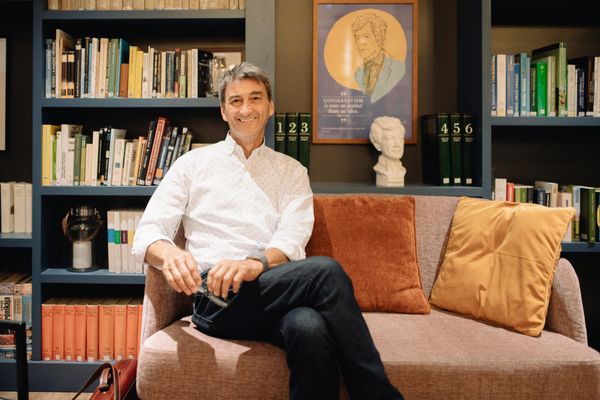
If you miss out, you drop out - interview with Zoltán Cséfalvay
